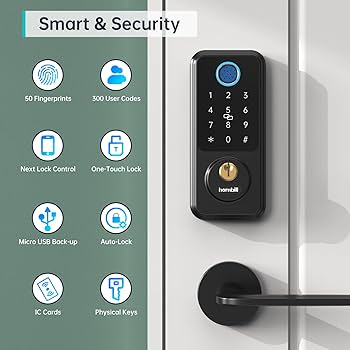Have you ever considered the thin line between convenience and security when it comes to smart locks? With the growing popularity of smart home technology, the question of how safe smart locks truly are becomes increasingly important. As you weigh the pros and cons of this modern convenience, it’s crucial to understand the potential risks that accompany these innovative devices.
Vulnerabilities in Smart Lock Technology
- When considering the safety of smart lock technology, it’s crucial to address the potential vulnerabilities that can compromise its security. One significant area of concern is remote hacking, where unauthorized individuals exploit weaknesses in the smart lock system from a distance. Remote hacking can occur through various means, including exploiting Bluetooth vulnerabilities present in some smart locks.
- Bluetooth vulnerabilities are a common entry point for hackers aiming to compromise smart lock systems. These vulnerabilities can allow unauthorized individuals to intercept communication between the smart lock and its connected devices, potentially enabling them to gain unauthorized access to the lock. Hackers may use specialized tools to exploit these vulnerabilities, posing a significant security risk to smart lock users.
- To mitigate the risks associated with Bluetooth vulnerabilities, it’s essential for smart lock manufacturers to regularly update their firmware and security protocols. Users should also take precautions such as using strong, unique passwords and enabling two-factor authentication to enhance the security of their smart lock systems. By staying vigilant and proactive, users can help protect their smart locks from potential remote hacking threats.
-

How Safe Is Smart Lock?
Potential Security Risks of Smart Locks
- With the focus on addressing vulnerabilities that compromise smart lock security, it’s imperative to examine the potential security risks inherent in smart lock technology.
- Smart lock hacking poses a significant threat, as cybercriminals can exploit weaknesses in the system to gain unauthorized access to your home or property. These hackers may intercept communication between the smart lock and the mobile app, allowing them to unlock doors without your knowledge.
- Additionally, the risk of data breaches is a pressing concern. If the smart lock’s database is compromised, sensitive information like access codes and entry logs could be exposed, jeopardizing your security and privacy.
- It’s essential to stay vigilant and take necessary precautions to mitigate these risks. Regularly updating your smart lock’s firmware, using strong, unique passwords, and implementing multi-factor authentication can help enhance the security of your smart lock system and reduce the likelihood of falling victim to potential security breaches.
Ways to Enhance Smart Lock Safety
- To bolster the safety of your smart lock system, implementing additional layers of authentication is a prudent measure. One significant aspect to focus on is smart lock encryption. Ensure that your smart lock utilizes strong encryption protocols to protect the communication between the lock and the connected devices. Encryption adds a layer of security by encoding the data exchanged, making it harder for potential hackers to intercept and decipher sensitive information.
- Another vital step to enhance smart lock safety is to closely manage remote access controls. Limit the number of users who’ve remote access to your smart lock system, and regularly review and update permissions. Enable two-factor authentication for remote access to add an extra barrier against unauthorized entry. Regularly monitor and audit remote access logs to detect any suspicious activity promptly.
Comparison: Smart Lock Vs. Traditional Lock
- Enhancing the safety measures of your smart lock system through encryption and remote access controls sets the stage for a comparative analysis between smart locks and traditional locks. Smart locks offer benefits such as keyless entry, remote monitoring, and the ability to grant access to guests from anywhere. These features enhance convenience and security by allowing you to control access to your home remotely. Additionally, smart locks can send real-time alerts to your smartphone, notifying you of any unauthorized attempts to enter your home.
- On the other hand, traditional locks rely on physical keys or combinations for access. While they’ve been the standard for many years, they lack the advanced security features that smart locks provide. Traditional locks can be susceptible to lock picking, bumping, or unauthorized duplication of keys. Moreover, if you lose your keys, there’s a risk that they could fall into the wrong hands, compromising the security of your home.
Tips for Securing Your Smart Lock
- For optimal security with your smart lock system, consider implementing additional authentication measures beyond just a passcode or fingerprint scan. One crucial tip is to enable two-factor authentication, requiring a secondary form of verification, such as a unique code sent to your phone, before granting access. This adds an extra layer of protection against unauthorized entry.
- When it comes to remote access, be cautious. Ensure that the connection between your smart lock and the app on your phone is encrypted to prevent potential hackers from intercepting the data. Using a virtual private network (VPN) can also enhance the security of your remote access by creating a secure connection over the internet.
- Regularly updating your smart lock’s firmware is essential. Manufacturers often release updates to address vulnerabilities and improve security features. By keeping your smart lock up to date, you can better shield it from potential cyber threats and ensure that it operates at its most secure capacity.
Conclusion
In conclusion, while smart locks offer convenience and modernity, it’s crucial to be aware of their vulnerabilities and potential security risks. By taking proactive measures to enhance smart lock safety and considering the comparison with traditional locks, you can better protect your home and belongings. Remember to stay informed, update your technology regularly, and follow best practices for securing your smart lock to minimize the risk of unauthorized access.


